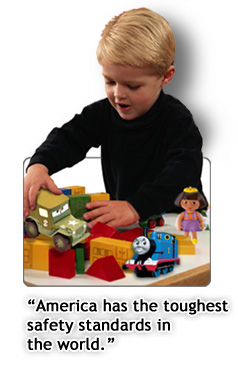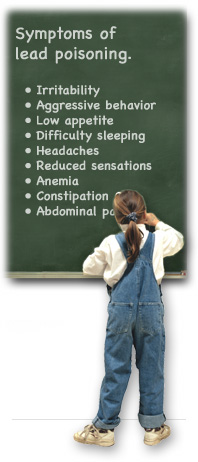
 Another day, another toy recall. It's the holiday shopping season, but you can't feel very merry if you're worried about "unsafe" toys. You've heard the reports. Thomas the Tank Engines laced with lead. Polly Pocket dolls made with gut-twisting magnets. Aqua Dots sprinkled with date-rape drugs. The list goes on and on. A decade from now, you might be calling this The Year of the Misfit Toys, or maybe the year when Good Toys Went Bad. How can so many toys enter this country in such dangerous condition? Government and toy industry officials say the surge in recalls is due largely to greater scrutiny of imported products. (Which kind of implies we've always had misfit toys in our midst.) Some speculate that the increased vigilance may make this Christmas season the safest of all. What's the truth... and what should you do this year? Another day, another toy recall. It's the holiday shopping season, but you can't feel very merry if you're worried about "unsafe" toys. You've heard the reports. Thomas the Tank Engines laced with lead. Polly Pocket dolls made with gut-twisting magnets. Aqua Dots sprinkled with date-rape drugs. The list goes on and on. A decade from now, you might be calling this The Year of the Misfit Toys, or maybe the year when Good Toys Went Bad. How can so many toys enter this country in such dangerous condition? Government and toy industry officials say the surge in recalls is due largely to greater scrutiny of imported products. (Which kind of implies we've always had misfit toys in our midst.) Some speculate that the increased vigilance may make this Christmas season the safest of all. What's the truth... and what should you do this year?
The floodgates open
Kids put all kinds of things in their mouths. Who doesn't have a story of swallowing a penny in their baby books? But when you're talking about toys...toys...the prize possessions of childhood, they ought to be safe. It's a frightening reality, however, if you've kept up with the growing list of the million or so recalled toys and what can happen because of them.
Take magnets. Many toys contain them. If they come loose, children can swallow them. Inside the intestines, two magnets can attract and puncture the intestinal wall, block the intestines, or cause blood poisoning, infection, or even death. Earlier this year, a 20-month-old toddler died, and at least 19 other children needed surgery, after swallowing magnets from toys.
Just this fall, we heard the ridiculous story about candy-like beads from the popular toy, Aqua Dots. The dots easily stick to a child's fingers and can be licked off or eaten. These dots are also covered with a sticky glue containing a chemical that metabolizes into a potent drug when a child eats them -- the same chemical as a date rape drug. At least one child was hospitalized after eating the beads.
Many of the recalls involve toys that contain high amounts of lead. Most are imported from China (which some might call The Land of Misfit Toys). Lead poisoning is more insidious than the other problems plaguing toys this year. Over time, the toxic metal can build up in a child's brain and nerves. The long-term results can range from delayed growth to kidney trouble to learning disabilities to behavior problems.
 Before 1978, when lead-based paint was banned in the United States, the walls of most houses were probably painted with plenty of it. In these older houses today, lead from paint or contaminated soil mingles with dust. This dust, in turn, settles on toys (and other surfaces) and gets inhaled. While a child can eat lead by chewing on a toy, banging the toy against something can add lead chips to an already toxic dust. Before 1978, when lead-based paint was banned in the United States, the walls of most houses were probably painted with plenty of it. In these older houses today, lead from paint or contaminated soil mingles with dust. This dust, in turn, settles on toys (and other surfaces) and gets inhaled. While a child can eat lead by chewing on a toy, banging the toy against something can add lead chips to an already toxic dust.
"We don't need any additional sources of lead," says David Bellinger, MD, professor of neurology at Harvard Medical School. "It's ubiquitous still in our environment, so anything that adds to the background exposure is undesirable.
What's really upsetting, says Bellinger, is that preventing lead exposure is simple... keep away from it. But how can you prevent exposure if lead-laced toys are flooding the market?
If we can't solve this problem, how are we going to address some of the questions and exposures that we know so much less about?" he says. "There's a problem with surveillance in this country, and I think it puts parents in a difficult position." What happened?
It's pretty simple. We import a huge amount of goods into this country -- 80 percent of the toys sold in the U.S. come from China. The sad truth is that some of these foreign manufacturers still use lead-based paint; some make toys so shoddily that small, dangerous parts break free; and some have poor quality control over the chemicals coating their products.
We can't even be sure of the quality of toys until they arrive in this country.
That's where the U.S. Consumer Product Safety Commission (CPSC) comes in. This federal agency orders recalls, establishes safety standards, and can randomly pull products from cargo ships, out of warehouses, and off of store shelves to test them. The CPSC, however, doesn't have the resources to stop every bad toy from leaving U.S. ports. The agency also can't stop foreign toymakers from shipping bad products here in the first place. And no federal agency has the authority to bless the safety of toys before they go on the market.
That duty lies with companies that import toys into the U.S., the so-called and often maligned realm of corporate responsibility. Although many companies test their products, by law they don't have to. If a company does find a defective or harmful product, however, it has to tell the CPSC within 24 hours or face fines and possible criminal charges. Otherwise, failing to meet quality standards costs toymakers only the expense of a recall, and loss of profit.
Profit alone should be incentive enough for toy companies to improve quality control to prevent these problems, but the product recalls keep coming, 32 alone from September through early November.
"It is unacceptable that retailers and importers are selling products for children that contain lead paint," says CPSC spokeswoman Patty Davis. "When we find them, we will move swiftly to remove them from the marketplace, and that's what you're seeing now."
While many foreign toymakers and importers have their own testing procedures, they have to do a better job, before the toys hit the market, says Frank Clarke, spokesman for the Toy Industry Association, whose 500-plus members account for about 85 percent of U.S. toy sales.
"America has the toughest safety standards in the world," he says. "What has fallen down here is the safety testing and inspection process to make sure that products conform to those standards. It's in that direction that the toy industry has been moving to make sure that it's fixed."
 What's being done? What's being done?
That's a work in progress. Consumer advocates want laws requiring independent, third-party testing of toys and other products for children. Congress is contemplating legislation that would force toymakers to have their products tested by a qualified lab and give the Consumer Product Safety Commission (CPSC) the power to certify the safety of toys. The toy industry, meanwhile, wants to do its own testing. (Any method of quality testing, by the way, is likely to impact the future price of toys.) Stay tuned on this debate.
For now, the toy industry is working with the CPSC on design changes that would prevent magnets from coming loose from toys. In the meantime, the industry has adopted a warning label for products that contain small magnets. As for lead paint, Chinese officials agreed to take immediate action to eliminate its use on toys exported to the U.S. But it's up to them to deliver on the promise.
You can bet you haven't seen the last of the recalls. Toymakers, importers, and retailers are testing and re-testing products as a result of the current crisis, says the CPSC's Davis. "But, there is anticipation that, as these systems are put in place to screen for lead paint, the number of violations may go down."
What can you do?
This holiday season, some people may be looking to buy toys made only in America or countries other than China, such as Germany. Is it a foolproof plan? Not necessarily. "The fact that a toy is made in the United States doesn't mean it's safe, unless it's been tested, too," says Clarke, the toy industry spokesman.
You can start buying home lead-testing kits, sold at most home improvement stores. But you could be wasting your money. The CPSC says you'll get false-positive and false-negative results. You could put your trust (and your wallet) in qualified lead-testing labs to check the safety of your kids' toys, but how realistic is that scenario?
It really comes down to parents and what they purchase. Here are some suggestions:
Buy age-appropriate toys. Remember, small parts fit into small mouths. Keep that in mind when buying things for older children and you have young ones, too. Be wary of online auction websites. Many recalled toys are showing up there for sale. Do your research. Check the product recall list (see below) before you buy anything.
If you can afford it, look for high-quality toys. You may pay more (and maybe buy fewer toys), but they're likely made well. At the very least, stay away from cheap toys. There's a reason they become misfit toys: Price isn't the only thing cheap about them.
For more information about toy recalls and what you can do this holiday shopping season, visit the following websites:
www.cpsc.gov/cpscpub/prerel/category/toy.html -- A list of all toys recalled by the Consumer Product Safety Commission since 1974
www.thedailygreen.com/environmental-news/latest/500-not-made-in-china-50110507 -- Lists of lead-free toys, toys "Not-Made-in-China," and other resources
www.creditcardhell.blogspot.com/2007/11/something-you-can-do-about-toy-recalls.html -- Numerous links to toy resources
www.toysafety.org/worstToyList_index.html -- A list of toys to avoid
www.toyinfo.org -- Facts and answers about toy safety, from the toy industry
service.mattel.com/us/recall.asp -- Information on recalls about toys sold by Mattel
Editor's Note: If you think your child might have lead poisoning, ask your child's pediatrician to order a blood-lead test.  | Jim Black, a freelance writer from Pittsburgh, doesn't have children and won't be buying toys this year for his nieces and nephews. Jim can be reached at featuredstories@adamcorp.com. |
|